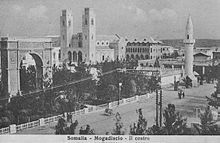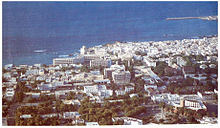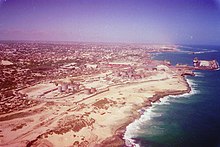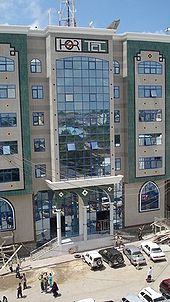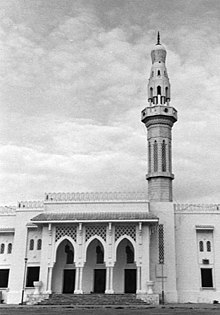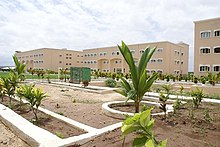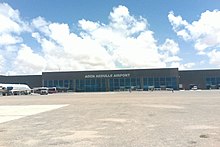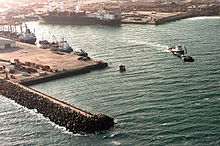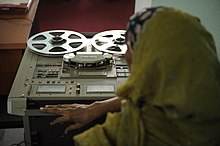Mogadishu
Mogadishu (in Somali, Muqdisho pronounced [mʉqdɪʃɔ]; in Arabic, مقديشو, romanized: Maqadīshū pronounced [muqaˈdiːʃuː], in Italian, Mogadishu pronounced /moɡaˈdiʃʃo/) is a city in southeastern Somalia, the federal capital of the country and the Benadir region. It is the main city of Somalia. It is located on the coast of the Indian Ocean.
It is located very close to the Earth's equator, but even so it has a very arid climate, with little rain, and the sea barely moderates the temperatures, which are very high with very hot summers. The Italians chose it as the capital of their Italian Somaliland in 1905 and since then it has become the main city of Somalia.
The capital city is home to many of the country's important institutions, including the Somali Government and Federal Parliament, both of which serve as the legislative branch of government. The port of Mogadishu serves as a major national seaport and is the largest port in the country. Aden Adde International Airport is the capital's main airport, and is the hub for the relaunched national airline Somali Airlines.
Mogadishu's authority over the rest of the country since 1990 is symbolic, because both the city and the rest of Somalia are divided into clan-run zones of influence.
Etymology
The city's name was long believed to be derived from the Persian Maq'ad-i-Shah (مقعد شاه), meaning "the seat of the Shah" (reflecting early Persian influence). It is known locally as Xamar (in English, Hamar). Another theory is that it was derived from the Arabic root 'mqds& #39;, which means 'sacred place'.
History
Early history
According to ancient records and tradition, southern Somalia, including the Mogadishu area, was inhabited very early by hunter-gatherers of Khoisan descent. Although many of these early inhabitants are believed to have been expelled or assimilated by later migrants in the area, physical traits persist in some ethnic minority groups in present-day Jubaland and other southern areas. Later descendants include relict peoples such as the Eile, Aweer, Wa-Ribi and, above all, the Wa-Boni. When populations of the Cushite Rahanweyn (Digil and Mirifle) clans arrived, they would establish a local aristocracy, others Cushite groups related to the Oromo (Wardai) and Hawiye (Ma'adanle) were already settled in the sub-region.
The ancient city of Sarapion is believed to be the predecessor of Mogadishu. It is mentioned in the Periplus of the Erythraean Sea, a Greek travel document from the s. I, as one of the trading ports on the Somali coastline. According to the "Periplo", trade by sea was already connecting towns in the Mogadishu area with other communities along the Indian Ocean coast.
The Sultanate of Mogadishu further developed with the immigration of Emozeidi Arabs, a community whose presence dates back to the 9th centuries and X. This evolved into the Muzaffar dynasty, a federation of Arab-Somali rulers, and Mogadishu became closely related with the powerful Somali Ajuran Sultanate. After the visit to the city, the Syrian historian of the s. XII Yaqut al-Hamawi wrote that it was inhabited by dark-skinned Berbers, the ancestors of present-day Somalis.
For many years, Mogadishu stood out as the most prominent city in the Bilad-ul-Barbar (بلاد البربر), or "Land of the Berbers," which was the term medieval Arabic for the Somali coast. When the Moroccan traveler Ibn Battuta reached the Somali coast in 1331, the city was at the height of its prosperity. He described Mogadishu as a "city of great proportions" with numerous wealthy merchants, famous for its high-quality textiles which it exported to places such as Egypt. Batutta also wrote that a Somali sultan, Abu Bakr ibn Sayx 'Umar, ruled the city and that he was originally from Barbara in northern Somalia. According to him, the sultan spoke Somali (according to Battuta 'Mogadiscian', the Benadir dialect of Somali) and Arabic with equal fluency. The sultan also had a retinue of viziers (ministers), experts in law, commanders, royal eunuchs, and other officers in his service.
In addition, it appears that there was a strong Persian presence in both Mogadishu and Zeila for a time. Some Shia influence can still be seen in some areas, such as the veneration of Fatima az-Zahra in southern Somalia, the daughter of the Prophet Muhammad. This is also reflected in the etymology of the city's name, which derives from Persian Maq'ad-i-Shah (مقعد شاه) and means "the seat of the Shah."
The Portuguese tried to occupy the city later, but failed to conquer it. In his travelogue of the expedition to the region between 1497 and 1499, the explorer João de Sá, who accompanied Vasco da Gama on the, wrote that Magadoxo (Mogadishu) was controlled by Moors. According to him, it was a large city surrounded by four towers, with multi-storey buildings and large palaces in the center. De Sá and his men bombarded the town before continuing south along the coast.The Somali Hawiye, however, managed to overthrow the Ajuran state and end the muzaffar rule.
Sultanates (19th and 20th centuries)
In 1882, Mogadishu was under the joint rule of the Somali Geledi Sultanate and the Omani Sultanate of Zanzibar. The Geledi sultans were at the height of their power. They controlled the ivory trade in the south and dominated the Juba and Shebelle valleys. The power of the Omani sultans in Mogadishu was merely nominal. When Imam Azzan bin Qais of Oman wanted to build a fort in the town, he was forced to seek permission from Sultan Ahmed Yusuf of Geledi. Garessa fort was built in 1870. The Sultan of Zanzibar first leased and then sold the infrastructure to the Italians, but the terrain remained Somali.
Italian Somalia (late 19th century to 1960)
In 1905, Italy named Mogadishu the capital of the newly established Italian Somaliland. The Italians began to call it by its current name Mogadiscio. After World War I the surrounding territory fell under Italian control with some difficulty.
Thousands of Italians moved to Mogadishu and created small manufacturing companies. They developed farming areas in the south, next to the capital, such as Janale and the Villaggio duca degli Abruzzi (today called Jowhar). In the 1930s new avenues and buildings were built. A 114 km narrow gauge railway was built from Mogadishu to Jowhar. An asphalt road was also built that was intended to link the city with Addis Ababa called Strada Imperiale.
In 1940, the population of Italian-Somali reached 22,000, 44% of the total population of 50,000 residents. Mogadishu remained the capital of Italian Somaliland until its demise. During World War II British forces captured the city in February 1941.
After World War II, Mogadishu became the capital of the United Nations Trusteeship Council of Somalia, a trustee political entity administered by the Italians under the United Nations mandate for 10 years (1950-1960).
Republic of Somalia (1960-1990)
British Somaliland declared its independence on June 26, 1960 and became the State of Somaliland, with the United Nations-mandated Italian-administered territory (formerly Italian Somalia) following in its footsteps five days later. On July 1960, the two territories merged to form the Republic of Somalia with Mogadishu as the nation's capital. A government appointed by Abdullahi Issa and other members of the protectorate government was formed, with Haji Bashir Ismail Yusuf as Chairman of the Somali National Assembly, Aden Abdullah Osman Daar as President of the Republic, and Abdirashid Ali Shermarke as Prime Minister (later 1967). to 1969 he would be its president). On July 20, 1961, by popular referendum, the people of Somalia ratified the new constitution, the first draft of which had been drawn up in 1960. In 1967, Muhammad Haji Ibrahim Egal became Prime Minister, a post appointed by Shermarke.
On October 15, 1969, while visiting the northern city of Las Anod, then Somali President Abdirashid Ali Shermarke was assassinated by one of his bodyguards. The assassination was quickly followed by a coup on 21 October 1969 (the day after his funeral) in which the Somali National Army seized power without armed opposition. It was a bloodless coup. It was sponsored by General Mohamed Siad Barre, who was in charge of the army at the time.
Alongside Barre, the Supreme Revolutionary Council (SRC) that came to power was led by Lieutenant Colonel Salaad Gabeyre Kediye and Police Director Jama Korshel. Kediye was officially the "Father of the Revolution", and Barre became head of the SRC shortly thereafter. The SRC renamed the country the Somali Democratic Republic, arrested members of the previous civilian government, he banned political parties, dissolved parliament and the Supreme Court, and suspended the constitution.
The revolutionary army implemented several large-scale public works programs, such as the Mogadishu Stadium. In addition to the program of nationalization of industry and land, the new Mogadishu-based regime acquired a foreign policy with an emphasis on Somalia's traditional and religious ties to the Arab world, eventually joining the Arab League in 1974.
After suffering defeat in the Ogaden War in the late 1970s, the Barre administration began detaining government and military officials suspected of involvement in the 1978 coup attempt. those who had allegedly helped organize the coup were executed. However, several officers managed to escape abroad and began to form the first of several dissident groups dedicated to overthrowing the Barre regime by force.
Civil War
By the late 1980s, the Barre regime was increasingly unpopular. The authorities reached a very high level of totalitarianism and resistance movements, supported by the Ethiopian communist Derg administration, sprang up all over the country. This led to the outbreak of a civil war in 1991, the overthrow of the Barre government, and the disbandment of the Somali National Army. Many of the opposition groups began to compete to fill the power vacuum that followed Barre's fall. Armed factions led by commanders Mohamed Farrah Aidid and Ali Mahdi Mohamed, both from the United Somali Congress, clashed over exercising authority in the capital.
United Nations Security Council Resolution 733 and United Nations Security Council Resolution 746 led to the creation of the United Nations Operation in Somalia I (UNOSOM I), the first stabilization mission in Somalia after the dissolution of the central government. United Nations Security Council Resolution 794 was passed unanimously on December 3, 1992, and called for the formation of a US-led coalition of United Nations Peacekeepers. After the formation of UNITAF (Unified Task Force), the alliance had to ensure security until humanitarian aid was transferred to the UN. After arriving in 1993, the peacekeeping coalition began the United Nations Operation in Somalia II (UNOSOM II), mainly in the south of the country.
Some of the militias vying for power interpreted the presence of UN troops as a threat to their hegemony. Therefore, several armed battles occurred in Mogadishu between peacekeepers and local guerrillas. Among them, the 1993 battle for Mogadishu, the arrest of several high-ranking lieutenants from the Aidid faction. The UN soldiers finally withdrew on March 3, 1995 due to heavy casualties.
In 2006, the Union of Islamic Courts (UTI), an Islamist organization, seized control of most of the south of the country and instituted sharia, or Islamic law. The new Somali Transitional Government (TFG), established two years earlier, tried to regain control. With the help of the Ethiopian Armed Forces, AMISOM peacekeepers and US air support, he managed to expel the ICU and strengthen control of the area. On January 8, 2007, in the midst of the Battle of Ras Kamboni, the president and TFG founder Abdullahi Yusuf Ahmed, a former colonel in the Somali army, entered Mogadishu for the first time since his term began. The government moved to Villa Somalia in Mogadishu from its previous location in Baidoa. It was the first time since the fall of the Barre regime in 1991 that the federal government controlled the majority of the country.
After the defeat, the Union of Islamic Courts split into various factions. Some of the more radical, such as Al-Shabbaab, regrouped with the intention of continuing the insurgency against the TFG and in opposition to the Ethiopian military presence in Somalia. During 2007 and 2008, Al-Shabbaab won military victories and seized control of ports and strategic cities in the center and south of the country. As of late 2008, the group controlled Baidoa, but not the capital. In January 2009, Al-Shabbaab and other militias had forced Ethiopian forces to withdraw, abandoning poorly equipped African Union peacekeeping forces to support Transitional Federal Government troops.
From May 31 to June 9, 2008, representatives of the Federal Government of Somalia and the moderate Islamist rebel group Alliance for the Reliberation of Somalia (ARS) participated in a peace conference in Djibouti sponsored by the UN. The peace conference ended with the signing of an agreement providing for the withdrawal of Ethiopian troops in exchange for an end to the armed confrontation. Parliament was expanded to 550 seats to accommodate ARS members, who elected a new president. With the help of a reduced team of African Union troops, the coalition government began a counter-offensive in February 2009 to regain control of the south of the country. To strengthen that control, the TFG created an alliance with the Islamic Courts Union, other members of the ARS, and Ahlu Sunna Waljama'a, a moderate Sufi militia.
In November 2010, a new technocratic government was elected, which implemented numerous reforms, particularly with regard to national security. By August 2011, the new administration and its AMISOM allies had succeeded in recapturing all areas of Mogadishu from control of the Al-Shabbaab militia. Since then, Mogadishu has undergone a period of intense reconstruction sponsored by the Somali diaspora, municipal authorities and Turkey, a longstanding ally of Somalia.
Reconstruction
In August 2011, the Al-Shabbaab militia carried out a strategic withdrawal from Mogadishu and returned to the hit-and-run tactic. Mayor Mohamed Nur pointed to the opportunity to stabilize and rebuild the city by all means as critical. With the close collaboration of the UN, the United States Agency for International Development and the DRC, the Nur administration began a large-scale reconstruction of roads and infrastructure in general. Residents of the city collaborate to a large extent with police and civil authorities to strengthen security. Nur noted the opportunity to transform Mogadishu even if resources are limited.
With the approval of a new Somali Constitution in 2012 and the subsequent election of a first president to the Federal Government of Somalia, the mayor's office continued to oversee the city's post-conflict reconstruction. The Benadir administration launched a city-wide street naming, street numbering, and postal code establishment project. The program is called the Street Numbering and Postal Code System and is a joint initiative of municipal authorities and representatives of the Somali business communities. According to Nur, the initiative is also intended to help law enforcement authorities and resolve disputes over private property. As of 2016, there are already postal codes for 176 localities, including the Mogadishu metropolitan area.
Geography
Mogadishu is located on the Indian Ocean coast in the Horn of Africa, in the Benadir (gobol) administrative region, in southeastern Somalia. The region is the same size as the city and is much smaller than the historical province of Benadir. The city is divided into Abdiaziz, Bondhere, Daynile, Dharkenley, Hamar-Jajab, Hamar-Weyne, Heliwa, Hodan, Howl-Wadag, Karan, Shangani, Shibis, Waberi, Wadajir, Wardhigley and Yaqshid districts. Strategic points of the city are the old city of Hamarwein, the Bakaara Market and the Gezira Beach. Mogadishu's beaches have coral reefs and are the setting for the first tourist enclaves to emerge in many years.
The Shebelle River (Webiga Shabelle) rises in central Ethiopia and reaches 30 km from the Indian Ocean near Mogadishu before turning southwest. During February and March it remains without flow, the rest of the year it serves to irrigate crops of sugar cane, cotton and banana.
Climate
For a city located so close to the equator, Mogadishu has a relatively dry climate. It is classified within the semi-arid climate (according to the Köppen Climate Classification), like the rest of southeastern Somalia. In contrast, the cities in the north of the country tend to have an arid climate.
Mogadishu is located in the bioclimatic zone of subtropical thorny forest according to the Holdridge Classification. The average annual temperature of the city is 27 °C, with an average maximum of 30 °C and an average minimum of 24 °C. The average monthly temperatures vary by about 3 °C, which corresponds to a type of hyperoceanic climate. The average annual precipitation is 429.2 mm. There are 47 rainy days per year, associated with a 12% daily chance of showers. The city has an average of 3,066 hours of sunshine per year and 8.4 hours of sunshine per day. The daily average of sunlight is 8 hours and 24'. The annual percentage of sunny days and cloudy days is 70% and 30%, respectively. The mean solar azimuth angle at noon on the 21st of the month is 75.
| Month | Ene. | Feb. | Mar. | Open up. | May. | Jun. | Jul. | Ago. | Sep. | Oct. | Nov. | Dec. | Annual |
|---|---|---|---|---|---|---|---|---|---|---|---|---|---|
| Temp. max. abs. (°C) | 39.5 | 39.5 | 37.3 | 39.8 | 34.9 | 33.0 | 34.3 | 36.0 | 36.0 | 37.0 | 39.0 | 37.3 | 39.8 |
| Average temperature (°C) | 30.2 | 30.2 | 30.9 | 32.2 | 31.2 | 29.6 | 28.6 | 28.6 | 29.4 | 30.2 | 30.6 | 30.8 | 30.2 |
| Average temperature (°C) | 26.6 | 26.9 | 28.0 | 28.9 | 28.2 | 26.7 | 25.4 | 25.9 | 26.5 | 27.3 | 27.5 | 26.9 | 27.1 |
| Temp. medium (°C) | 23.0 | 23.4 | 24.9 | 25.6 | 24.9 | 23.7 | 23.1 | 23.0 | 23.4 | 24.3 | 24.2 | 23.5 | 23.9 |
| Temp. min. abs. (°C) | 19.0 | 19.2 | 19.4 | 18.0 | 18.4 | 18.0 | 16.8 | 18.0 | 18.0 | 17.5 | 16.2 | 16.5 | 16.2 |
| Total precipitation (mm) | 0 | 0 | 8 | 61 | 61 | 82 | 64 | 44 | 25 | 32 | 43 | 9 | 428 |
| Precipitation days (≥ 0.1 mm) | 0.3 | 0.1 | 0.6 | 4.8 | 6.7 | 12.7 | 13.3 | 10.2 | 4.9 | 3.9 | 4.1 | 1.5 | 63.0 |
| Hours of sun | 266.6 | 251.4 | 282.1 | 261.0 | 272.8 | 219.0 | 226.3 | 254.2 | 264.0 | 266.6 | 261.0 | 257.3 | 3082.3 |
| Relative humidity (%) | 78 | 78 | 77 | 77 | 80 | 80 | 81 | 81 | 81 | 80 | 79 | 79 | 79 |
| Source: Deutscher Wetterdienst | |||||||||||||
Government
Federal
The Transitional Federal Government (TFG) was the internationally recognized central government of Somalia from 2004 to 2012. Located in Mogadishu, it was the executive branch of government.
The Federal Government of Somalia was established on 20 August 2012, at the same time as the TFG's interim mandate ended. It marks the country's first permanent central government since the start of the civil war. The Federal Parliament of Somalia Somalia is the legislative branch of the government.
Municipal
Mogadishu's municipal government is led by Yusuf Hussein Jimaale, who succeeded Mayor Hassan Mohamed Hussein Mungab, a former president of the military court. Other municipal development initiatives include a US$100 urban regeneration plan million, the creation of garbage processing and incineration plants, a city-wide clean-up project, the creation of cement and asphalt factories, the rehabilitation of the parliament and city hall buildings, the reconstruction of the former Ministry of Defense, the reconstruction of penal institutions and health facilities, the establishment of a police training center and a permanent base in Jasiira for the new Somali Armed Forces, the reconstruction of the headquarters of the Somali Postal Service and the rehabilitation of recreational areas for children in various districts. In January 2014, the Benadir administration launched the system a for house numbering and postal codes. In March of the same year, it began distributing national identity cards. In addition, local authorities began renovating major local government centers in September 2014, including the former Fisho Guverno complex In January 2015, an office for health and safety to oversee both fields was also opened in the city, and launched a municipal beautification campaign in advance of various international congresses being held in the city.
In March 2015, the Benadir administration completed the SECIL project in conjunction with the EU and UN-HABITAT. The 3.5 million euro initiative lasted three and a half years and enabled the creation of a sustainable waste collection system, a Center for Technical Studies, water quality testing laboratories, improved access to drinking water, improvement of job opportunities in the low-cost fuel production sector, reinforcement of construction techniques and regulation in the sector and laboratories to test the quality of construction materials.
Diplomatic missions
Some countries maintain embassies and consulates in Mogadishu. As of January 2014, diplomatic missions include the embassies of Djibouti, Ethiopia, Sudan, Libya, Yemen, Saudi Arabia, Turkey, Iran, Uganda, Nigeria, the United Kingdom, Japan, China, and Qatar. Some embassies with reopening plans are those of Egypt, the United Arab Emirates, Italy and South Korea.
In May 2015, in recognition of Somalia's sociopolitical progress and return to an effective state of government, US Secretary of State John Kerry announced a preliminary plan to re-establish the US embassy in Mogadishu. He noted that while there were no set timetables for relaunching the facility, the US government had already begun to upgrade its diplomatic representation in the country. Somali President Hassan Sheikh Mohamud and Prime Minister Omar Abdirashid Ali Sharmarke also offered Kerry a deal. of land reservation for the US complex. Simultaneously, Mohamud signed an agreement with the head of the EU delegation in Somalia Michele Cervone d'Urso to facilitate the opening of more embassies in Mogadishu of European Union countries. The EU also announced that it had opened an EU delegation office in the city.
In February 2014, Minister of Foreign Affairs and International Cooperation Abdirahman Duale Beyle announced that the federal government intended to reopen the Mogadishu Institute of Diplomacy. The center was in the past a very important national institution for diplomacy and international relations. Beyle also pointed to the reopening of the institute's diplomacy department, the information and broadcasting department, and the library.
Economy
Mogadishu has always been a commercial and financial hub. Before the massive importation of clothing from Europe and the United States, the city's textile sector sold to much of the African interior, the Arabian Peninsula, and the Persian Gulf.
Mogadishu's economy has grown rapidly since pacification in mid-2011. The SomalFruit factory was reopened, as was the Coca Cola factory. In May 2012, First Somali Bank opened in the capital, the first bank It has been open in southern Somalia since 1991. In addition, the historic Central Bank has reopened and a business center is under construction.
The resurgence of Mogadishu's real estate sector was facilitated in part by the establishment of a local construction plant in November 2012 by the Istanbul municipality and the Turkish Red Crescent. More than 50 construction trucks and machinery were imported from Turkey for the plant to produce concrete, asphalt and bricks for the construction industry. Istanbul also intended to provide 100 specialists for long-term infrastructure modernization.
In mid-2012, Mogadishu hosted the first ever Technology, Entertainment, Design (TED) talk. First Somali Bank organized the event to showcase improvements in the business, development and security sectors to international investors and potential Somalis. A second TEDx talk on entrepreneurship occurred the following year in the capital to discuss startups. and business opportunities in the city.
Several large companies are headquartered in Mogadishu. Among them is the Transnational Gas and Electricity Industrial Company, an energy conglomerate founded in 2010 that brings together five large Somali companies in the areas of trade, finance, security and telecommunications. Other companies include Hormuud Telecom, the largest telecommunications company in central and southern Somalia; Telcom, another telecommunications service provider; the Somalia Power Company, specializing in the generation, transmission and distribution of electrical power to residents and businesses in the Benadir area. In addition, the International Bank of Somalia, which opened in the city center in 2014, offers banking Islamic insurance and international banking services through a SWIFT code system. The Islamic Insurance Company is the first insurance company to operate in the city in many years. The Central Bank of Somalia, the national monetary authority, also has its headquarters in Mogadishu.
In June 2013, former Prime Minister Abdi Farah Shirdon signed a foreign direct investment law. The draft was prepared by the Minister of Commerce and Industry together with government lawyers. Once approved by the cabinet, it establishes a safe legal framework for foreign investment in Mogadishu and elsewhere in Somalia.
In October 2014, the Tawakal Money Express (Tawakal) company began construction of a tertiary building with financial services, a supermarket, a hotel, a restaurant and conference rooms. The Al Buruuj company launched a real estate project in January 2015 Daru-Salam City, financed by the Salaam Somali Bank and to be built in the northern area of the capital.
Demographics
| Historical population | ||
|---|---|---|
| Year | Pob. | ±% |
| 1936 | 50 000 | - |
| 1941 | 72 000 | +44.0% |
| 1944 | 72 000 | +0.0% |
| 1947 | 73 000 | +1.4% |
| 1950 | 55 000 | 24.7% |
| 1953 | 63 000 | +14.5% |
| 1956 | 75 000 | +19.0% |
| 1959 | 104 332 | +39.1% |
| 1962 | 116 222 | +11.4% |
| 1965 | 171 312 | +47.4% |
| 1968 | 172 700 | +0.8% |
| 1972 | 230 000 | +33.2% |
| 1982 | 500 000 | +117.4% |
| 1984 | 570 000 | +14.0% |
| 1991 | 900 000 | +57.9% |
| Sources: Italian Somalia, British Administration during Italian Somalia, UN and municipal censuses and estimates of Mogadishu; administrative changes have been able to affect population figures. | ||
Mogadishu is a multi-ethnic city. The original population consisted mainly of Bushman aborigines and later received Kushite, Arab and Persian migrants. The mixing of these groups produced the Benadiri or Reer Xamar people ("people of Mogadishu"), a unique amalgamation-population from the Benadir region. During the colonial period, European expatriates, especially Italians, contributed to the cosmopolitan character of its population.
The main area of Bantu population in Somalia used to be the settlements in the south, mainly between the Jubba and Shebelle rivers, as well as in the Bakool and Bay regions. In the early 1970s, more Bantu began to move to urban centers such as Mogadishu and Kismayo. Displacement sparked by the civil war in the 1990s increased the number of rural minorities migrating to urban areas. Consequently, the traditional demographic composition of Mogadishu has changed a lot.
Following the significant improvement in security in 2012, many Somali expatriates have begun to return to Mogadishu in search of investment opportunities and to contribute to the post-conflict reconstruction process. Through private and public initiatives, such as the Somali Diaspora Corps, are participating in the reconstruction of schools, hospitals, banks and other infrastructure. Their role in the recovery process of the capital is crucial. They have also helped boost the local real estate market.
According to Demographia, Mogadishu has a population of about 2,120,000 as of 2015. It is the 222nd city by population in the world. The urban area occupies 92 km² and the population density is 23,400 inhabitants per square kilometer. In September 2014, the Ministry of Planning and International Cooperation launched Somalia's first census in more than two decades. The United Nations Population Fund assisted the Ministry with the project, which is expected to be completed before the plebiscite and local and national elections planned for 2016.
Points of Interest
Places of religious worship
Arba'a Rukun Mosque is one of the oldest Islamic places of worship in the city. It was built around 1268, at the same time as the Fakr ad-Din Mosque. The Arba'a Rukun mihrab contains an inscription dating from that year and commemorating its founder, Khusra ibn Mubarak al-Shirazi (Khusrau ibn Muhammed).
The Islamic Solidarity Mosque was built in 1987 with financial support from the Saudi Fahd bin Abdelaziz Foundation. It is the main mosque of the city and an iconic building for Somali society. It has a capacity for 10,000 worshipers and is the largest in the entire Horn of Africa. In 2015, the federal authorities completed a project to restore the mosque's infrastructure. The improvements are part of a broader government program to improve the capital's mosques. Municipal authorities are also restoring the historic Central Mosque in central Mogadishu.
Mogadishu Cathedral was built in 1928 by the colonial authorities of Italian Somaliland. Known as "Cattedrale di Mogadiscio", it was built in the Norman Neo-Gothic style following that of the Cathedral of Cefalù in Sicily. The church was the seat of the Diocese of Mogadishu. It was badly damaged during the civil war. In April 2013, following a visit to the ruins to inspect its condition, the diocese announced a plan to restore the building.
Palaces
Villa Somalia is the official residence and usual place of work of the President of Somalia, Hassan Sheikh Mohamud. It stands on a hill overlooking the city and the Indian Ocean, with good access to both the port and the airport. The Governor's Palace was the seat of the Governor of Italian Somaliland and the later Somali Trust.
Museums, libraries and theaters
The National Museum of Somalia was established after independence in 1960, when the former Garesa Museum was converted into the National Museum. This was transferred in 1985, renamed the Garesa Museum and converted into a regional museum. In January 2014, it has important cultural collections such as ancient coins, tools, traditional art, ancient weapons and ceramics.
The National Library of Somalia was opened in 1975 under the responsibility of the Ministry of Education and Culture. In 1983, it had some 7,000 books and a similar number of cultural and historical archives, and was open to the general public. In the 1990s it closed its doors. In June 2013, the Heritage Institute for Policy Studies organized a shipment of 22,000 volumes from the United States to Somalia as part of a library restocking program. In December, authorities launched a program to rebuild the national library. With Zainab Hassan as director, the federal program will invest $1 million to build a new library complex in six months. An additional 60,000 volumes are expected to arrive from other Arab League countries.
The Somali National Theater opened in 1967 as the cultural epicenter of the capital. It closed after the start of the civil war in the 1990s, but reopened in 2012 after being reconstructed. In September 2013, the Somali federal government and its Chinese counterpart signed an official cooperation agreement as part of a national recovery program for 5 years. Thanks to the pact, the Chinese authorities will rebuild the national theater and other important points of interest in the city.
Markets
Bakaara market was born in 1972 by the Barre administration. It functioned as an open-air market for goods and services such as products and clothing. After the start of the civil war, the market fell into the hands of various military groups that used it as an operational base. After the pacification of 2011 the market began to renew itself. Stores of all kinds were rebuilt, such as fruit, clothing, and construction materials. As in the rest of the city, the price of real estate on the market has increased a lot. In 2013, the local company Tabaarak rented a new warehouse in the market for US$2,000 per month.
In February 2014, the Benadir administration began rebuilding the Ansaloti market in the Hamar Jajab district. Before it closed in the early 1990s, it was one of the largest markets in the city. In September 2014, the municipal authorities officially opened it to the public.
Institutes
The Regional Somali Language Academy is an intergovernmental regulatory body for the Somali language in the Horn region. In January 2015, the country's president announced that its creation would be done in conjunction with the governments of Djibouti and Ethiopia. A new headquarters for the academy was scheduled to be built in Mogadishu in recognition of Somalia as the main patron nation and diffuser of the Somali language. In February 2015 the first stone of the academy was laid during an inauguration ceremony.
Hotels
Mogadishu has many newly built hotels. The main clients are returning expatriates, investors and workers from the international community. Hotel representatives have begun to attend international industry conferences, such as the Africa Hotel Investment Forum.
There are numerous hotels, some near the airport. The rest are located mainly in the downtown area, such as the Oriental, Peace, Shamo or Taleex hotels.
Education
Mogadishu has several educational institutions. The government's urban renewal program will remodel and reopen 100 public schools in the capital.
The Somali National University (SNU) was established in the 1950s during the trust period. In 1973 the facilities and studios were expanded. Over the next twenty years the SNU developed extensively to have 13 departments, 700 employees, and 15,000 students. On November 14, 2013, the government unanimously approved a federal plan to reopen the university, which had been closed since the early 1990s. The renovation plan cost US$3.6 million, and was completed in August 2014..
Mogadishu University (MU) is a non-governmental university run by a board of trustees and a university council. It is the birthplace of many professors from the Somali National University and other Somali intellectuals. It is financed by the Islamic Development Bank of Jeddah, Saudi Arabia, and other donor institutions. The university hosts hundreds of graduates in seven faculties. Some continue to study a master's degree abroad thanks to a scholarship program. The University of Mogadishu has partnered with other academic institutions such as Aalborg University in Denmark, three universities in Egypt, seven in Sudan, the University of Djibouti, and two universities in Yemen. In 2012 the MU is accredited by the EDU Intergovernmental Organization Council.
In 1999, the president at the time Hassan Sheikh Mohamud established the Somali Institute of Management and Administration (SIMAD) in Mogadishu, which would later become SIMAD University, with Mohamud as dean until 2010. It offers university programs in various fields such as economics, statistics, commerce, accounting, technology, computer science, health sciences, education, law and public administration. Aussi SIMAD Graduate School (SGS) a été créée in 2012 pour améliorer les connaissances professionnelles des apprenants dans leur Domaine de prédilection et les aider à passer à l'étape suivante de leur vie avec une perturbation minimale de leur responsabilité sur le terrain. I propose nombreux programs, where there is a master's degree in project management, a master's degree in quality management, a master's degree in HRM business administration, a master's degree in marketing business administration, a master's degree in entrepreneurial business administration, a maîtrise en administration des affaires en finance conventionnelle, une maîtrise en administration des affaires en islamique Finance.
Benadir University (BU) was established in 2002 with the intention of training physicians. Since then, it has expanded into other fields. Another educational institution in the city is the Jamhuriya University of Science and Technology. The Turkish Boarding School has also been created, and the campuses of Mogadishu Polytechnic Institute and Shabelle University are also being renovated. In addition, the campus of a new Islamic university is also being built. In April 2014, Prime Minister Abdiweli Sheikh Ahmed laid the cornerstone for the reconstruction of the old Mogadishu meteorological school. A new aviation academy is under construction at Aden Adde International Airport.
Other educational institutions in the city include City University, created in 2012 with the intention of providing quality research.
Health
The city has the Banadir Maternal and Child Hospital (Somali: Isbitaalka Banaadir) is a hospital and medical school in the Wadajir (Medina) District. The hospital has a maternity service and a pediatric unit.
Sports
Mogadishu Stadium was built in 1978 during the Barre administration with the help of Chinese engineers. The venue was used for sports activities such as the Somali Cup and for football matches of teams from the Somali First Division. Presidential speeches and political rallies also took place there. In September 2013, the Somali federal government and its Chinese counterpart signed an infrastructure reconstruction pact that included the Mogadishu Stadium.
Banadir Stadium and Konis Stadium are two other major sports venues in the city. In 2013, the Somali Football Federation carried out a renovation project for the Konis Stadium with artificial turf donated by FIFA. The Ex-Lukhino basketball stadium in the Abdiaziz District also underwent a US$10,000 rehabilitation provided by local company Hormuud Telecom. Additionally, the municipal authority oversaw the reconstruction of the Banadir Stadium.
Other sports bodies are based in Mogadishu. Among them, the Somali Football Federation, the Somali Olympic Committee, the Somali Basketball Federation and the Somali Karate and Taekwondo Federation.
Transportation
Roads
Mogadishu is connected to other towns in Somalia and neighboring countries by road. The capital contains a very extensive network of gridded streets. In October 2013, work began on the road leading to the airport by Somali and Turkish engineers. The works finished in November and included lane demarcation. This work was part of a larger agreement between the Somali and Turkish governments to twin Mogadishu and Istanbul in order to modernize the capital's road network. The Turkish International Development and Cooperation Agency (TIKA) then began a program to clean up the entire city additional to the municipal program. More than 100 garbage collection vehicles and other TIKA machinery cleaned the streets of the city. The Benadir administration took over the project in March 2015.
Between 2012 and 2013, the city government along with the British and Norwegian governments began installing solar-powered streetlights on the city's main streets. The initiative was carried out with equipment imported from Norway, cost $140,000 and lasted several months. Solar panels and streetlights have contributed to improving nighttime visibility and the image of the city.
Minibuses are the most common form of public transportation in Mogadishu. The second most used mode of mobility are autorickshaws (tuk tuks). There are about 3000 and they have multiple designs. Autorickshaws are a cheaper alternative to taxis and minibuses, costing half the fare for the same distance with flexible fares. Being affordable and fuel-efficient, three-wheelers are often a business option for entrepreneurs with few resources. They tend to prevail on shorter journeys. In June 2013, two taxi companies began offering their services: Mogadishu Taxi, with more than 100 vehicles, and City Taxi, the other competitor. Both offer a flat fee of $5 per service.
In January 2014, the Benadir administration launched a city-wide street naming, street numbering, and postal code project. The program is called the Street Numbering and Postal Code System and is a joint initiative of municipal authorities and representatives of the Somali business communities. The initiative is also intended to help law enforcement authorities and resolve disputes over private property. In March 2015, renovation of Mogadishu's main Hawo Asir-Fagah road was also started, with the intention of facilitating access to private vehicles in the area and make it resistant to any type of meteorological phenomenon.
Aerial
After independence, Aden Adde International Airport served flights to multiple international destinations. In the mid-1960s, the airport was expanded to accommodate international carriers. At that time, the flag carrier Somali Airlines offered regular flights to all major cities. In 1969, the airport also began receiving small private planes.
The facility grew a lot in the post-independence period thanks to successive renovation projects. With the outbreak of the civil war in the early 1990s, flights arriving at the airport began to have systematic problems and the facilities were destroyed. In the late 2000s, K50 Airport, located 50 km to the south, served as the main airport while Mogadishu International Airport, now called Aden Adde, closed its doors for a while. However, as of late 2010, Mogadishu saw a general improvement in security and the federal government ended up taking control of the city in August 2011.
In May 2011, the Ministry of Transport announced that SKA-Somalia had been contracted to run operations at the reopened Aden Adde Airport for ten years. Among the first moves, estimated at $6 million, SKA purchased new airport equipment and expanded services by hiring and training 200 local workers to comply with international regulations. The company also refurbished the facilities, restored electricity reliably, upgraded the terminal's baggage handling facilities and arrival and departure areas, installed electronic check-in systems and strengthened security. It also provided internet services to the Somali Weather and Civil Aviation Agency, immigration, customs, airlines, and the Somali Police Force. In January 2013, shuttle buses were launched to take passengers to the terminal.
In December 2011, the Turkish government announced plans to modernize the airport as part of Turkey's broader commitment to the reconstruction process. Among others, systems and infrastructures were renovated, such as the new control tower. In September 2013, the Turkish company Favori LLC began operating at the airport and announced plans to renovate the terminal building, build a new one, and improve other services. The project has a 10 million dollar budget and will expand the current capacity of 15 daily flights to 60. The new airport terminal was opened in January 2015. It has modern facilities and contemporary architecture and will expand the airport's capacity to 60 daily flights, that is, about 1,000 passengers per hour.
As of January 2015, the largest operating carriers serving Aden Adde Airport included private airlines Jubba Airways, Daallo Airlines, and African Express Airways, as well as UN charter Turkish Airlines, and Felix Airways (Al Saeeda Airlines). The airport offers direct services to other Somali cities such as Galkayo, Berbera and Hargeisa, as well as international destinations such as Djibouti, Jeddah, and Istanbul.
In July 2012, Mohammed Osman Ali (Dhagah-tur), the director general of the Ministry of Aviation and Transport, announced that the Somali government had begun preparing to relaunch the Mogadishu-based flag carrier Somali Airlines. The first aircraft were planned to be received in December 2013.
Maritime
The port of Mogadishu, also known as the International Port of Mogadishu, is classified as a first-class port and is the largest in the country.
During the civil war it suffered damage, so the federal government created the Mogadishu Port Rehabilitation Project, an initiative to rebuild, develop and modernize the port. The renovation included the installation of Alpha Logistics technology. A joint international delegation between the Djiboutian ports and Chinese authorities specialized in infrastructure reconstruction visited the facilities in June 2013. According to the port's director, Abdullahi Ali Nur, the delegates and the Somali authorities were briefed on the functions of the port and the stages of the reconstruction project.
In 2013, the port management reached an agreement with representatives of the Iranian company Simantech Shipping LLC to take over the operations of the facility. The name of the company is Mogadishu Port Container Terminal and it is in charge of the operational and technical functions of the Port of Mogadishu.
In October 2013, the federal government reached an agreement with the Turkish company Al-Bayrak to run the port for a period of 20 years. The Ministry of Ports and Public Works ratified the agreement and assigned Al-Bayrak the task of rebuilding and modernizing the facilities. In September 2014, the transfer of management to Al-Bayrak became effective. The cost of the modernization project is 80 million dollars.
Railway
During the 1980s, projects were announced to revive the 114 km railway line between Mogadishu and Jowhar, built by the Italians in 1926 but dismantled in World War II by British troops. It was originally built with the intention of reaching Addis Ababa. Today only a few sections of track are in use in the port of Mogadishu.
Media
Mogadishu has historically been a media hub. The Somali Film Agency (SFA), the national film regulatory agency, was established in 1975 in Mogadishu. The agency organized the annual Mogadishu Pan-African and Arab Film Symposium which brought together film professionals and experts. from all over the world, especially from North Africa and the Arab world, as well as from Asia and Europe.
There is a network of broadcasting agencies in Mogadishu. Radio Mogadishu is the public federal government broadcaster. It was established in 1951 during Italian Somaliland and broadcast news in both Somali and Italian. The station was modernized with Russian help after independence in 1960 and began broadcasting in Somali, Amharic, and Oromo. It ceased operations at the beginning of the civil war, but the National Transitional Government officially reopened it in the early 2000s. Other stations in the city include Mustaqbal Radio, Radio Shabelle, Radio Bar-Kulan, Radio Kulmiye, Radio Dannan, Radio Dalsan, Radio Banadir, Radio Maanta, Gool FM, Radio Xurmo, and Radio Xamar, also known as the "Voice of Democracy".
The Mogadishu-based Somali National Television (SNTV) is the central government broadcaster. On April 4, 2011, the Ministry of Information of the Transitional Federal Government reopened the network as part of a national telecommunications sector development initiative. SNTV broadcasts 24 hours a day and can be seen both in Somalia and abroad. by terrestrial and satellite.
Somali popular music has a large following in Mogadishu and was widely consumed before the civil war. When the government retook the city in mid-2011, radio stations were able to play music again. On March 19, 2012, the city was the scene of an open-air concert that was broadcast on television. In April 2013, the musical collective Waayaha Cusub organized the Music Festival for Reconciliation, the first international festival of music that took place in Mogadishu in two decades.
Twinnings
Mogadishu is twinned with:
| Country | City |
|---|---|
Featured Characters
Contenido relacionado
Trois-Rivieres (Quebec)
San Isidro District (Lima)
Geography of Japan


